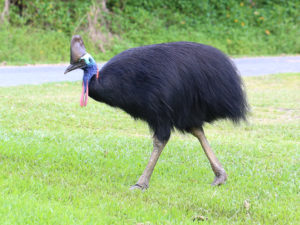It is a shaggy black-feathered cousin of the turkey, the size of a smallish emu with a raptor claw on each foot. It jumps five feet high, attacks with its claws first, and leaves egg-hatching to the males while the females find more mates. It’s a relative of the dinosaurs and is almost as old. It’s big, it’s kind of ugly. It’s the southern cassowary.

Photocredit: Summerdrought
But I didn’t know any of this early Wednesday morning. My husband, son, and I piled into Dean the tour guide’s van along with six Australian tourists and two Kiwis. Dean wore a little microphone headset so he could talk to us as he drove toward Mossman. My son wanted to sit in the “way-back,” and as Dean zipped around turns at 60kph, the van lurching left and right and left again, I silently cursed my child. Dean looked like the real-life rainforest version of Crocodile Dundee if Crocodile Dundee worked for a tour company. He was a one-man band and his trumpet was the cassowary. “We just might get a look at one today,” he said with the spark of a quest, “so keep your eyes peeled.”
I had my heart set on seeing a platypus, the weirdest creature on the planet. What was the big deal about the cassowary, a big, non-flying bird? Still, the way he said it – “we just might get a look” – piqued my curiosity.
I had found Dean’s company after asking locals where we could take a tour that actually goes into the rainforest, as far as you can go in a day. Many of the tours didn’t go beyond the Daintree River, and considering one local told me flat out, “You’re not seeing the rainforest unless you’re across the Daintree River,” this seemed like a problem. Dean’s company was the only one we could find that went far beyond the Daintree River and would take my five-year-old son.
Dean drove the van onto a rusty cable ferry that held, at most, ten vehicles at a time. Seconds later we were crossing the Daintree river: a quiet, muddy flow of water that reminded me of upper parts of the Mississippi. This cable ferry was the only means of vehicle transport on the whole river, and it didn’t even run 24-hours a day. As we hummed along, Dean talked about the history of deforestation and how rainforest had been converted to sugarcane fields and grazing land for cows as fast as land barons could buy it up. Finally, after protests that included one man burying himself up to his neck just feet in front of a bulldozer, the rainforest gained government protection in the 1980s. We disembarked and continued onto a gravel road. Dean pointed left to a road sign: a yellow diamond with a black cassowary silhouette. “See: keep a lookout. They’re around.”
I stared out the side window as we wound through the forest, scanning between trees and vines for a bright blue head or red wattle. I was starting to get car-sick.
Finally, we unloaded at a makeshift dirt parking area and headed onto the trails. As I learned that everything in the rainforest will kill you (more on that in a later post) I noticed Dean’s eyes occasionally dart to one side or the other. Trail number two, trail number three: the same. His mouth was steady, explaining everything from cloud stripping to the desalinating root systems, but his eyes were unpredictable. Several times he stopped midsentence and cupped his hand to his ear – “thought I heard one” – or raised his binoculars to his eyes – “nope, but keep an eye out.”
By early afternoon he had the whole group acting like paranoid conspiratorialists. “Just call out if you see one. Don’t be shy now.” And they did call out when they saw one, or at least when they thought they saw one. “No, sorry Dean. My mistake,” the man from Perth said for the second time in an hour, followed by a collective sigh.
“S’alright mate! Just keep looking.”
We were on the last trail before heading back to the river when Dean stopped us. “Hold up now, hold up.” He stepped off the trail with the greatest of care, avoiding even the smallest saplings and what I could only identify as weeds. “There,” he said, pointing to the dirt. “Can you all see that? Come right to the edge, get a good look.”
The older couple in front of me inched to the edge of the trail and leaned forward. “Oohhh,” the woman cooed. “Would you look at that.”
I waited my turn and ushered my son forward. “What is it, Mommy? What are we looking at?” I hesitated to answer because I honestly wasn’t sure. Then, I saw it. A dinnerplate-size pile of brown chunks, interspersed with colorful seeds and other undigestibles.
“It’s poop, dear,” I said, knowing my response would delight him. Poop is every five-year-old boy’s favorite thing, after all.
“Yes!” Dean held out his arms jubilantly. “It is poop! Or scat, dung: whatever you like to call it.”
“Dung!” my son giggled with glee. His new favorite word, I was sure.
“And not just any dung. This is cassowary dung, and it’s the reason we’re all able to be here today in this wonderful rainforest.” Dean’s zeal was truly infectious. Here we were, ten adults and a kid, eyes wide with wonder about a giant pile of bird poop. I wanted to kidnap him and make him educate my child for the next thirteen years.
“The cassowary is what we call a keystone species, meaning it’s a keystone to the survival of the rainforest…” Dean explained that cassowaries, being not so smart, eat all kinds of seeds and fruits they can’t even digest. The seeds and fruits pass through the bird body unharmed and land on the rainforest floor surrounded in a nice warm pile of dung, the perfect fertilizer, where they are free to sprout new life. In fact, there are over 100 varieties of plant-life that rely on the cassowary as its sole means for propagation; they cannot reproduce on their own. So, in short, no cassowaries means 100 fewer kinds of plant life, and that means a vastly changed rainforest that probably wouldn’t be a rainforest at all.
Wow.
As our tour cluster moved down the trail, I lingered and bent down close to the dung pile. In an odd sort of way I felt affection for it. Gratitude even. It, and the giant ugly endangered bird it came out of, were central to my even being here, experiencing this mysterious place where everything is deadly but also so beautiful you forget the life-threatening part and just revel in amazement at how it all works in harmony. Nothing is superfluous, not least of all the cassowary.
We never spotted a cassowary that day (nor a platypus, as it turns out they’re nocturnal). I did eventually have a cassowary encounter: one wandered across the designated walking path in an animal sanctuary I visited. I nodded as it passed in front of me, lowering my eyes briefly as if it were royalty. It stopped, tapped the ground twice with its oversized turkey foot, and walked away.
There are only about 1500 southern cassowaries left in Queensland. To learn more about the southern cassowary and what you can do to protect it, visit http://savethecassowary.org.au/.

Recent Comments